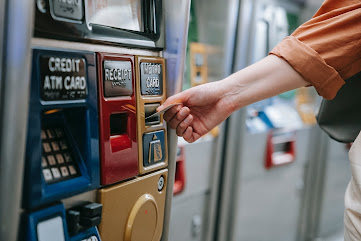The World's first Automated Teller Machine (ATM) was installed on June 27, 1967 by the Barclays Bank in England. It was inaugurated by the English actor Reg Varney. The ATM at Barclays was developed by John Adrian-Barron. But it was not like today's cash machine.
 |
| ATM Machine -Representative Image |
In 1969, the ATM that was installed in USA was called the Docuteller. Because it was manufactured by the Docutel company. At that time, it had a sizeable steel body. In this context, we have to remember Luther George Simjian who invented a less successful prototype ATM in 1939. It was installed in New York by the City Bank of New York, till it's removal after six months.
In 1987, HSBC (The Hongkong and Shanghai Banking Corporation Limited) installed India's first ATM in Mumbai.
The Union Bank of India installed India's first talking ATM at the Blind People's Association, Ahmedabad, on June 6, 2012.
A gold ATM, which delivers gold coins, was also launched at Hyderabad on December 3, 2022.
Pink, Green, Orange, Brown, Yellow Label ATMs
Pink label ATMs are exclusively meant for ladies.
ATM for agricultural purposes is known as green label ATMs.
ATMs with Orange label stands for shared transactions.
Brown label ATMs are operated by a third party, apart from the bank or credit unions.
ATMs with Yellow label stands for e-commerce transactions.
White label ATMs
ATMs owned and operated by non-banking entities are known as White label ATMs. The main purpose of the White label ATMs (WLAs) is to expand the ATM network.
One can deposit cash, check account status, make regular payments, generate mini statement etc. by using WLAs.
How ATM Works?
An
Automated Teller Machine (ATM) is a convenient way to access your bank account
24/7. Here's a simplified breakdown of how it works:
Key
Components:
- Card Reader: Reads the magnetic stripe
or chip on your debit or credit card.
- Keypad: Allows you to input your
Personal Identification Number (PIN) and select transaction options.
- Cash Dispenser: Dispense cash from its
internal safe.
- Receipt Printer: Prints a paper record of
your transaction.
- Screen: Displays messages and
prompts for user interaction.
- Internal Computer: Processes transactions and
communicates with your bank's computer system.
Transaction
Process:
- Card Insertion: You insert your card into
the card reader.
- PIN Entry: You enter your PIN on the
keypad.
- Transaction Selection: You choose the desired
transaction (withdraw cash, check balance, etc.) on the screen.
- Amount Entry: If withdrawing cash, you
enter the amount.
- Bank Verification: The ATM sends your request
to your bank's computer system.
- Authorization: Your bank verifies your
account balance and PIN, authorizing or denying the transaction.
- Cash Dispense (if approved): The ATM dispenses the
requested cash.
- Receipt Printing: The ATM prints a receipt
detailing the transaction.
Security
Measures:
- PIN Encryption: Your PIN is encrypted to
protect it from unauthorized access.
- Card Authentication: The ATM verifies your
card's authenticity with your bank.
- Surveillance Cameras: ATMs often have cameras to
deter and record suspicious activity.
- Tamper Detection: ATMs have sensors to detect
tampering attempts.
- Regular Maintenance: ATMs are regularly serviced
to ensure security and proper functioning.
By understanding these basic steps and security measures, you can use ATMs confidently and securely to manage your finances.
Note: Contents published here has been taken from various sources for reference purpose. Readers are requested to do their own study before using them in any medium.
Comments
Post a Comment